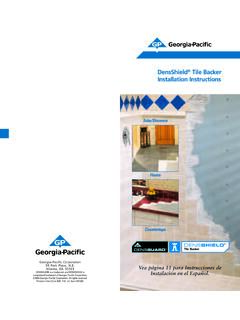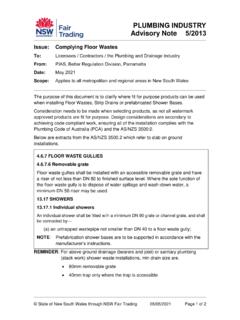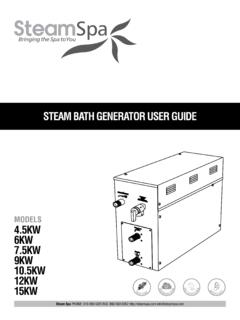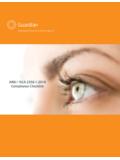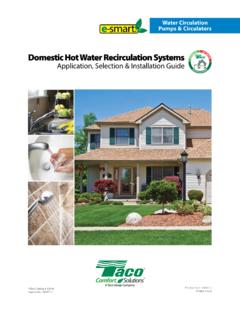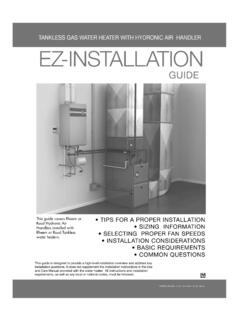Transcription of 2021 OREGON PLUMBING SPECIALTY CODE (OPSC)
1 Page 1 of 11 2021 OREGON PLUMBING SPECIALTY CODE (OPSC) Summary of changes The following is a list of significant changes adopted in the 2021 OREGON PLUMBING SPECIALTY Code (OPSC) from the 2017 OPSC. These changes consist of new and existing OREGON amendments, and new model code provisions approved by the State PLUMBING Board. No. Section Heading and type of change Summary Chapter 3 1 UPC OPSC Dead Legs. (Adopted new model code) New model code requires dead legs to have a method of flushing. This new model code change does not define how long a line is to be considered a dead leg, any waterline that is connected to the distribution system that is not serving a fixture, appliance, or appurtenance, will be considered a dead leg and require a method of flushing. 2 Freezing Protection. (Retained existing amendment) OREGON deletes , in attics or crawl spaces, This OREGON amendment has been retained from last cycle.
2 Freeze protection may still be required for water piping in these locations if not installed within the insolation. Retaining in attics or crawl spaces would cause some confusion on requiring the drainage to be protected from freezing. Chapter 4 3 Water-conserving PLUMBING fixtures and fittings and Table (Adopted new amendment) These new amendments add requirements for water conserving PLUMBING fixtures and fittings for the Executive Order. This new code amendment became effective Oct. 1, 2020, this interim effective date was to meet executive order 17-02 and a new foot note was added during the code change cycle for kitchen sinks. These new water conserving rates came out of appendix L, sustainable practices. These new requirements are only for new structures. *These amendments rescinded the 2017 OPSC amendments (exceptions) to Sections and 4 Limitation of Hot Water Temperature for Public Lavatories.
3 (Adopted new model code) Model code added that water heaters complying with ASSE 1084 can be a means for compliance with the requirements to limit the maximum temperature of water to 120 F. Also see Sections for bathtubs and whirlpool bathtubs and for bidets. This is a new model code change, this allows a water heater meeting ASSE 1084 to be used as a limiting device, versus the point of use 1070. This is an option to the ASSE 1070. This new allowance also is effective for sections , , and 7 Finished Curb or Threshold. (Adopted and modified new model code and retained existing amendments) Model code added language: Where there is a shower without a threshold, the floor space within the same room shall be considered a wet location and shall comply with the requirements of the building, residential, and electrical codes The committee modified this section to replace wet location with wet room and retained the OREGON amendment that eliminated the rest of the paragraph that points to other codes.
4 Committee retained the definition of wet room, which is an OREGON amendment. This definition also points to a barrier free shower . Page 2 of 11 No. Section Heading and type of change Summary 8 shower Compartments. (Rescinded existing amendment) The OREGON amendments adding an exception for wet rooms with specific requirements is rescinded. This section is no longer necessary with the additional language in that allows a barrier free shower . 9 Nonwater Urinals with Drain Cleansing Action. (Adopted new model code) Model code added a section that addresses nonwater urinals that have a drain cleansing action, this added feature to the urinal may require a water connection, and also meet ASME Chapter 5 11 Electric Water Heaters. [2017 OPSC ] (Rescinded existing amendment) The OREGON amendments in 17 ORSC Section , allowing electric water heaters to be placed on the garage floor is rescinded.
5 Electric water heaters can still be put directly on the garage floor, the language in the 2021 OPSC is specific to gas water heaters for clearance in a garage. Chapter 6 12 Water Supply and Flushing. (Rescinded existing amendment) The OREGON amendment deleting the exception for listed fixtures that do not require water for their operation and are not connected to the water supply is rescinded. Model code has added two new exceptions to this section that address the listing for nonwater fixtures and the amendment is no longer needed. 13 Dual Check Backflow Preventer. (Adopted new model code) Mode code added language defining dual check backflow preventer as that which consists of two independently acting check valves, force loaded to a normally closed position. This new language in is not new to OREGON , OREGON has a current amendment that allows a dual check on yard hydrants in section that allows a device meeting ASSE 1024.
6 This new section just defines the device. 14 Laboratory Faucet Backflow Preventers. (Adopted new model code) Model code added language in the body of code for the application of ASSE 1035, which is referenced in Chapter 17. This is not a new standard, it s currently in chapter 17 and references Section 301. This section is new in the code body. 15 Chemical Dispensers. (Adopted new model code) Model code added a new section for the requirement of an ASSE 1055 device on a chemical dispensing unit, these are units that are usually installed on sink faucets. This new section is not a new requirement just a clear cite and write path now. 16 Tracer Wire. (Adopted new model code) Model code increased the required tracer wire size to be not less than 14 AWG. In the 2017 OPSC, tracer wire was required to be minimum 18 gage, this has changed to 14 AWG gage for longer life span.
7 The wire still has to be direct burial. Page 3 of 11 No. Section Heading and type of change Summary 17 T. Materials for bldg. supply and water distribution piping and fittings. (Adopted new model code) Model code added ASTM F1986, which is the standard for multilayer pipe type 2 and compression fittings for hot and cold drinking-water-systems, with a maximum pressure rating of 145 psi at 180F. This standard was in Chapter 17 of the 2017 OPSC; model code moved it to Table for user convenience. This is a multilayer polyethylene and PEX pipe, rated at 145 PSI and 180 degrees. This piping requires specific listed fitting to the same standard and are compression fittings. There are a few other standards that have been added to the table. SS fittings, ASTM F3226, PVC, AWWA C907, PE-RT has several new standards for fittings, CPVC, has added ASSE 1061 most of these standards are not new to our Chapter 17 but have been move to the table for user convenience, for example the ASSE 1061 is for push-fit fittings (like SharkBite).
8 18 PVC Plastic Pipe and Joints exposed to direct sunlight. (Adopted new model code) Model Code moved these requirements from Chapter 3 [2017 OPSC ]. The exception for PVC water piping that is protected by water based synthetic latex paints is now in Section This change from Chapter 3 to Chapter 6, makes this requirement more specific to UV exposed water pipe. the code requires all water piping to be protected from freezing and to be located minimum 12 below frost depth outside the building, this code requirement will seldom be required based on standard installation requirements, because all exterior water pipe cannot be exposed. 19 Leak Detection Devices. (Adopted new model code) Model code added a section requiring water supply and distributions that have leak detection devices to comply with IAPMO IGC 115 or IAPMO IGC 349. These devises are inline devises that sense a water leak by flow volume and trigger a shut off of the water supply.
9 The standards are also new to Chapter 17. 20 Excessive Water Pressure. (Adopted new model code) Model code added language in the body of code for the application of ASSE 1003, which is referenced in Chapter 17. The existing OREGON amendments deleting the requirement that pressure regulators equal to or exceeding 1 inches to have a strainer are retained. The existing OREGON amendment changing the requirement for a properly sized and sloped boresighted drain to daylight to requiring "adequate means to provide drainage is retained, as it gives more flexibility for drainage from a pit. 21 Expansion Tanks, and Combination Temperature and Pressure-Relief Valves. (Rescinded existing amendment) The existing OREGON amendment prohibiting the installation of a valve between the expansion tank and the system is rescinded. This amendment was in conflict with the boiler rules.
10 Also, there was confusion on the term between the tank and the system, somewhere interpreting this to also mean the tank could not be downstream of the water heater shut off valve. Page 4 of 11 No. Section Heading and type of change Summary 22 Discharge Piping / Drains (Adopted model code and new amendment) (Rescinded existing amendments) The existing OREGON amendment deleting the section for discharge piping and adding a section for drains is rescinded. One of the goals of this code cycle was to retain as much model code language as possible. This allows industry to use IAPMO s Illustrated Training Manual and other recourses available from IAPMO to correctly interpret and understand intent. This is one section where we rescinded the OREGON amendments and went back to model code language. A new OREGON amendment was added to retain the garage floor as an acceptable point of disposal for the T&P.










